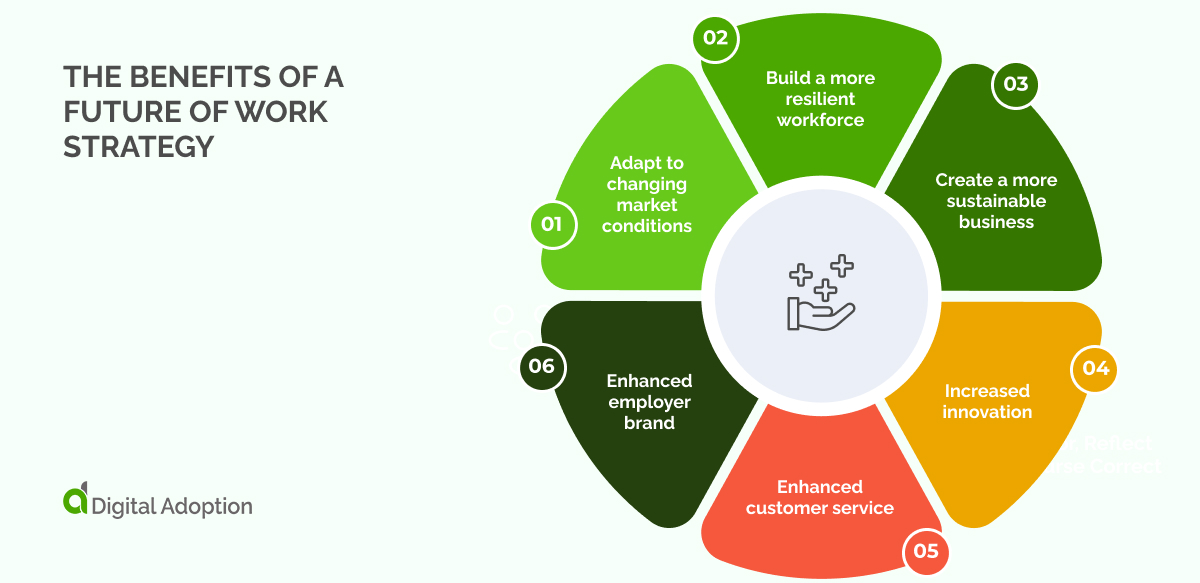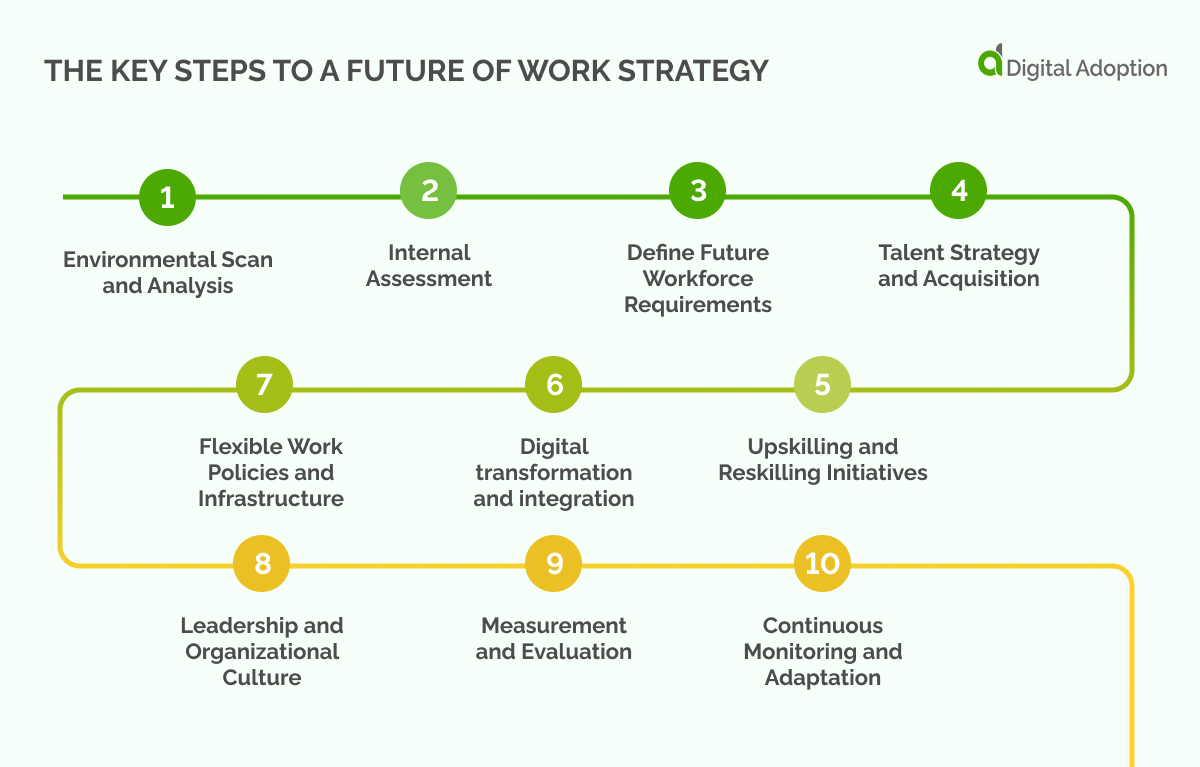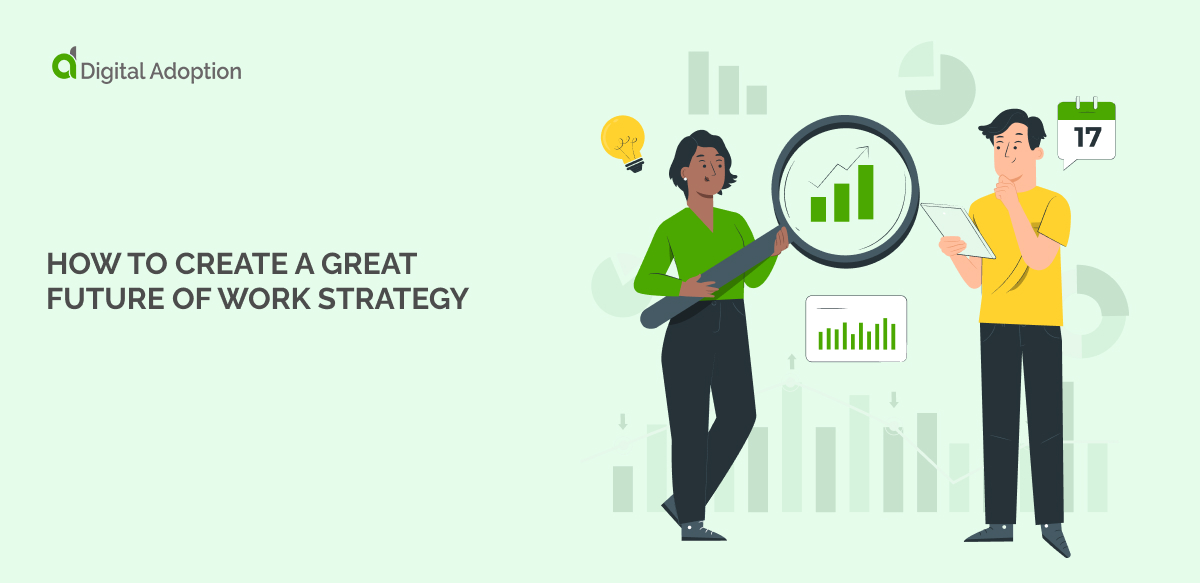Most people know that the future of work will be very different from the past. For better or worse, individual workers and companies must prepare themselves for dramatic upheavals in the coming years.
To get ready, you can consult with all the books, articles, and thought leaders you like: but if you don’t have a future of work strategy in place, you’re putting your company at risk. This article will help by explaining the main ideas that go into a strategy.
To investigate the deeper issues, we’ll go beyond working remotely, well-being, and customer expectations.
More specifically, this article will:
- Give you a quick reminder of what the “future of work” is – and what strategy means
- Explain why it’s really important that you have a future of work strategy
- Give you the steps you need to take to make the best future of work strategy
- On a final note, give a bigger picture view of the changing nature of work.
Accenture’s Future of Work survey from 2022 revealed that only 26% of CEOs have a good future of work strategy in place. Don’t be like them! Read on, and by the time we’re through, you should have everything you need to start confidently planning your strategy.
What is a future of work strategy?
A future of work strategy is a plan for businesses to adapt to the changing circumstances of the workforce.
The “future of work” refers to the anticipated changes in how people work and engage in economic activities. It covers the nature of jobs, work environments, work arrangements, and the impact of technological advancements, societal shifts, and economic factors on the workforce.
The future of work has become an extremely important topic since 2020. It is not just a question for theorists and academics. It is a highly practical issue, thanks to technological developments, the lessons learned from Covid, global economic instability (from war, climate change, and more), and changing societal values.
A future of work strategy helps a company to navigate all these changes and plan for the anticipated trends and challenges in the evolution of work. It encompasses a range of proactive measures and initiatives aimed at effectively leveraging technological advancements, adapting to shifting workforce dynamics, and optimizing productivity in the face of emerging opportunities and disruptions.
It focuses on aligning the organization’s workforce and operations with these evolving dynamics to remain competitive and agile in this rapidly changing landscape.
Why every business needs a future of work strategy
When you look into the future scenarios for work, there’s no question that a fully-developed future of work strategy can prevent some of the worst outcomes.
This section will focus on two aspects of the “why.” It will start with a short introduction to the major factors affecting the work environment. Then, it will describe some benefits of a successful future work strategy.
The factors changing the future of work
This article will not go deep into the factors that will make the future of work different – there is plenty of writing on this topic already (and you should read more about the subject!). Nonetheless, we’ll introduce three key trends that are making a difference in the work of today and tomorrow.
First and foremost, technological advancements in all workplace areas are making a major difference, like work. Automation, artificial intelligence, and robotics are reshaping industries and transforming the nature of work. A future of work strategy helps businesses utilize emerging technologies while ensuring that technological redundancy does not negatively impact their previous employees.
The rise of the gig economy is making a big difference in all kinds of work. This is a choice for some people: working freelance can be more interesting, profitable, and adaptable. On the other hand, the gig economy can hurt the most vulnerable workers (sometimes called the “precariat”) in society. Employers are increasingly responsible for providing assurances and benefits to employees not conventionally employed by them.
Globalization and remote work have entered the business world like never before in white-collar work. Today, it is easy for a business based in one place to hire workers in any country they like. This is a great opportunity, but it also comes with great responsibilities.
The benefits of a future of work strategy

The changes in the work environment could cause a business to sink completely. However, those who choose to swim (with a future of work strategy!) can neutralize these risks and even turn them to their advantage.
For example:
- Adapt to changing market conditions: The workplace constantly evolves, and businesses must adapt to these changes to remain competitive. A good future-of-work strategy can help businesses to anticipate and respond to these changes.
- Build a more resilient workforce: A flexible and adaptable workforce can withstand shocks and disruptions better. This can help businesses to weather economic downturns and other challenges.
- Create a more sustainable business: A good future of work strategy can help companies to reduce their environmental impact. This can be achieved by reducing commuting, encouraging telecommuting, and using more sustainable technologies.
- Increased innovation: Businesses open to new ways of working are more likely to be at the forefront of innovation. This is because they can attract and retain top talent and create an environment where creativity and risk-taking are encouraged.
- Enhanced customer service: Businesses that can provide flexible work options to their employees are more likely to meet the needs of their customers around the clock. This can lead to improved customer satisfaction and loyalty.
- Enhanced employer brand: Businesses with a strong future of work strategy are seen as more progressive and forward-thinking. This can attract top talent and make recruiting and retaining employees easier.
The key steps to a future of work strategy

It’s easy to talk about all the challenges and benefits of the future of work. But it takes time and effort to turn this into a meaningful strategy for your organization. This section will explain how developing a comprehensive future of work strategy involves several key steps. While the specific approach may vary depending on the organization’s context and objectives, you can adapt these for many circumstances.
Environmental Scan and Analysis
Conduct a thorough analysis of the external environment, emphasizing the trends that impact your industry. That will likely include technological trends, industry disruptions, demographic shifts, and regulatory changes. Assess how these factors affect the organization and its workforce.
Internal Assessment
Evaluate the organization’s workforce capabilities, skills gaps, technological infrastructure, and organizational culture. Identify areas of strength and areas that need improvement to adapt to future work requirements.
Define Future Workforce Requirements
Based on the analysis, define the key skills, competencies, and roles critical for the organization’s future success. Consider emerging technologies, automation potential, and changing customer demands to shape the workforce requirements.
Talent Strategy and Acquisition
Develop a talent strategy that aligns with future workforce needs. This may involve rethinking recruitment and selection processes, exploring alternative talent sources (such as freelancers or remote workers), and creating a diverse and inclusive talent pipeline.
Upskilling and Reskilling Initiatives
Identify skill gaps within the organization and design targeted upskilling and reskilling programs to equip employees with the necessary competencies for future roles. Leverage internal training resources, external partnerships, and digital learning platforms to facilitate continuous learning.
Digital transformation and integration
For any company, the future of work will likely require more digital transformation practices. As new technologies emerge and mature, finding ways to integrate them into your processes is important.
Even with good IT systems, keep your eyes open for new opportunities. A digital future is a certainty – but exactly what form it takes is still unknown. Data security, privacy, and change management will all be important.
Flexible Work Policies and Infrastructure
In 2023, we are still waiting to see what direction remote work will take. Some companies are gradually rolling back the freedoms of the Covid era, forcing their employees to come into a physical location more often. Others are continuing to reap the benefits of remote working.
Using your employees’ digital skills to the max is a great way to build agility into your working systems. So, as part of your strategy, review and adapt existing policies and infrastructure to support remote work, flexible schedules, and digital collaboration. Creating a good hybrid work schedule can be surprisingly challenging but pays off in the long run.
Leadership and Organizational Culture
Your leadership team has to stay up to date. Business leaders must handle future scenarios to ensure the changes succeed before they’ve even started. So, develop leadership capabilities that promote agility, innovation, and a future-oriented mindset. Foster an organizational culture that encourages continuous learning, embraces change, and supports employee well-being. If these qualities are part of your company culture, the talent pool for leadership positions will be much bigger.
Measurement and Evaluation
Getting a good set of KPIs together is important for the future of work. KPIs are a surprisingly tricky area to get right.
So, establish metrics and key performance indicators (KPIs) to measure the effectiveness of the future of the work strategy. Regularly assess progress, gather feedback, and adjust as needed to align the strategy with evolving needs.
Continuous Monitoring and Adaptation
These steps can be rounded off with continual monitoring of changing landscape. Most organizations will struggle.
Stay informed about emerging trends, technologies, and market shifts. Continuously monitor the internal and external environment to proactively adapt the strategy as required, ensuring it remains relevant and effective.
By following these steps, organizations can develop a future work strategy that positions them to thrive in the face of evolving work dynamics, technology advancements, and market disruptions.
What’s at stake in the future of work?
As a final note – remember that the question of the future of work is much bigger than one company’s success or failure. Redesigning job will have a major impact on the labor labor market. That impact might not be positive: indeed, it has the potential to make life difficult for great swathes of society.
In 1930, the leading economist John Maynard Keynes wrote an essay called “Economic Possibilities for Our Grandchildren”, giving a pioneering vision of the future of work in a technological age.
In Keynes’ view, “technological unemployment” is a good thing, heralding an age of minimal work and maximum ease, in which ambition becomes meaningless. He saw a time when providing our most basic needs would be very easily met. And the impact on people would be profound: “The course will be that there will be ever larger and larger classes and groups of people from whom problems of economic necessity have been removed.”
The reality is rather different.
Some writers continue to write utopian visions about a post-scarcity society. Most impressively, Aaron Bastani has argued for a version of “fully automated luxury communism” while demonstrating that a complete workless society is possible.
But most people continue to work in ever more miserable conditions. The leading critics Pfannebecker and Smith use the terms “misemployment” and “disemployment“ to explain the “different ways in which work has gotten worse” over the 2010s and early 2020s.
It will take more than well-being initiatives and remote work to change this. But what’s at stake are the very core qualities of our humanity. Addressing those issues will take a unified approach from individuals, businesses, and governments.
In the meantime, developing a future of work strategy is the most effective approach – and indeed the ONLY effective approach large organizations can take.
Get ready for future scenarios with a good strategy
It’s easy to understand how some leaders can fall behind in future planning.
There’s so much to read. So much to understand. And so much to process into a meaningful plan of action. What’s more, everything can change when you least expect it!
But if you’ve got the headspace, a future of work strategy can take shape quickly. Just remember:
- Future of work strategies responds to changes in working practices;
- A strategy can bring to the surface innovative ideas, trends analysis, and strong leaders;
- The strategy can be handled through a step-by-step strategic approach;
- With the best plans, research shows that a unified model for work’s future could benefit humanity enormously.
When all’s said and done, organizations with a good future of work strategy can become leaders in the field – and drivers of best practice. While PwC’s “workforce of the future” survey shows that over 70% of people still think that AI can’t replace the human mind, some companies are doing their best to hand over everything to robots.
So: creating your future of work strategy is not only a great way to ensure your business is sustainable. It’s a great way of creating the best future for us all.













